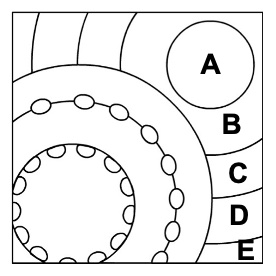IPHY 3410
Instructor: Dr. Leif Saul
Fall 2023

IPHY 3410Instructor: Dr. Leif Saul
|
 |
1. Most organs are made of ____ basic tissue types.
a. 1
b. 2
c. 3
d. 4
e. 5
2.
Which of the following cells has the most abundant lysosomes?
a. Muscle cell
b. Immune (defense) cell
c. Neuron (nervous cell)
d. Hormone-producing cell
3. Which element of the cytoskeleton would help reinforce the effectiveness of desmosomes?
a. Microtubule
b. Microfilament
c. Intermediate filament
d. All of the above
e. None of the above
4. Which type of cell junction would help epithelial tissue control exchange of materials with the environment?
a. Tight junction
b. Desmosome
c. Gap junction
5. In kidney tubules, why is the epithelium cuboidal instead of squamous?
a. It helps propel urine along the tubule
b. It provides more room for organelles
c. It protects the kidney from infection
d. All of the above
6. (Photo of stratified squamous epithelium.) This tissue sample may have been taken from:
a. Large blood vessel
b. Stomach
c. Alveolus of lung
d. Inside of mouth
e. Gland
7. Suppose the epithelial (outer) part of the skin is abraded completely, exposing the basement membrane. Which of the following would you predict?
A. The abrasion causes bleeding
B. Nerve branches are broken
C. Extra collagen is added in the repair process
D. A and B
E. A and C
8. Compared to skin epithelium, dense regular connective tissue would be expected to have:
a. More intermediate filaments
b. More desmosomes
c. Both A and B
d. Neither A nor B
9. What property do you predict for the multicellular membranes?
a. They have a basement membrane
b. They have areolar connective tissue
c. They are avascular
d. a and b
e. All of the above
10. You open your mouth and touch the inside of your cheek with your finger. Which of the following does your finger directly contact?
a. Serous membrane
b. Mucous membrane
c. Epithelium
d. a and c are both correct
e. b and c are both correct
11. As the cells in the stratum granulosum mature, are keratin (for mechanical protection) and glycolipids (for waterproofing) secreted out of the cell?
a. Both keratin and glycolipid are secreted
b. Neither keratin nor glycolipid are secreted
c. Only keratin is secreted
d. Only glycolipid is secreted
12. In the 1964 James Bond film Goldfinger, the villain kills his secretary by painting all of her skin with gold. Is this plausible (likely)?
a. Yes; it would prevent breathing through the skin.
b. Yes, as in (a). In fact, the actress died while filming.
c. Yes, but it would take days for the gold to reach the blood.
d. No. How can you believe a James Bond film?
14. The ability of ___ to resist ___ depends on ___.
a. Periosteum; tension; intermediate filaments
b. Bone tissue; compression; collagen
c. Dermis; tension; intermediate filaments
d. Epidermis; tension; collagen
e. None of the above
15. What structure do you predict for the flat bones of the skull?
a. Compact bone throughout
b. Medullary cavity sandwiched between compact bone
c. Spongy bone sandwiched between compact bone
d. Spongy bone throughout
e. Compact bone sandwiched between spongy bone

16. At the top and right sides of the image is another osteon (or partial osteon). Indicate the most recently deposited bone matrix in that osteon.
A
B
C
D
E
17. Which is (are) plausible function(s) of canaliculi?
a. Allow blood vessels to pass through
b. Improve communication between osteocytes
c. Allow diffusion of nutrients
d. All of the above
e. b and c
18. In intramembranous bone formation,
a. Epithelial cells cluster and become osteoblasts
b. Cartilage is used as a model and converted to bone
c. Mineralization occurs first, followed by collagen secretion
d. Osteocytes develop into osteoblasts
e. None of the above
19. What do intramembranous and endochondral ossification have in common?
a. Periosteum contributes to bone formation
b. Osteoblasts are not derived from cartilage cells
c. Calcification of cartilage
d. a and b
e. All of the above
ANSWERS:
1. d
2. b
3. c
4. a
5. b
6. d
7. b
8. d
9. d
10. e
11. d
12. d
13. a
14. e
15. c
16. b
17. e
18. e
19. d